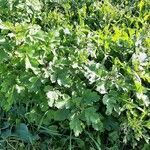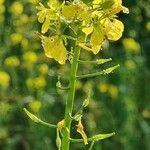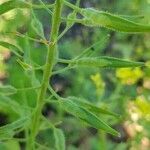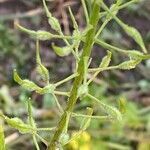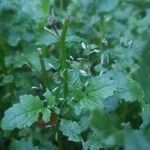Plants usually hispid, rarely glabrous. Stems often branched distally, (0.15-)0.25-1(-2.2) dm. Basal leaves: petiole 1-3 (-6) cm; blade oblong, ovate, or lanceolate (in outline), (3.5-)5-14(-20) cm × 20-60(-80) mm, margins lyrate, pinnatifid, pinnatisect; lobes 1-3 each side, (oblong, ovate, or lanceolate, 1.5-2.5 cm), margins usually dentate or repand, rarely pinnatifid. Cauline leaves (distal) shortly petiolate; blade (ovate or oblong-ovate, 2-4.5 cm), margins coarsely dentate, rarely subentire. Fruiting pedicels divaricate, (3-)6-12(-17) mm. Flowers: sepals (3.8-)4-7(-8) × 1-1.8 mm; petals pale yellow, (7-)8-12(-14) × (3-)4-6(-7) mm; filaments (3-)4-7(-8) mm; anthers 1.2-1.5 mm. Fruits lanceolate, (1.5-)2-4.2(-5) cm × (2-)3-5.5(-6.5) mm; valvular segment terete or slightly flattened, (0.5-)0.7-1.7(-2) cm, 2-5-seeded per locule; terminal segment ensiform, flattened, (1-)1.5-2.5(-3) cm, equal to or longer than valves, seedless; valves hispid, trichomes of 2 types (subsetiform mixed with shorter, slender ones). Seeds pale yellow to pale brown, (1.7-)2-3(-3.5) mm diam. 2n = 24.
Annual taprooted herb. Stem erect, branching, bearing stiff reflexed hairs especially near base, or sometimes glabrous, 60-100 cm tall. Lvs glabrous or sparsely covered in coarse hairs, toothed. Lower lvs lyrate-pinnate, rarely 2-pinnatifid, 10-20 × 5-10 cm; terminal leaflet broadly ovate to triangular, shallowly to deeply 3-lobed, wider than rest of lf; lateral leaflets alternate, oblong to ovate, in (0)-1-4 pairs, the proximal ones usually shallowly toothed but rarely entire. Upper lvs petiolate, similar to lower but smaller, sometimes simple and 3-lobed. Racemes erect, to 40 cm long, glabrous or with sparse reflexed hairs. Pedicels patent to reflexed at fruiting, 10-20 mm long. Sepals ovate to obovate, glabrous, 3-6 × 1-1.5-(2) mm. Petals 7-11 × 3-5 mm. Silique (1)-3-6-(8)-seeded, ± constricted between the seeds, bearing bristly hairs especially on veins, rarely glabrous, 15-30 × 2-5 mm; beak strongly flattened, 0-1-seeded, = or > valves.
Erect, usually branched herbs 30-60 cm high. Stems densely retrorsely hairy below, sparsely above, rarely glabrous. Leaves all petiolate, lyrate-pinnatisect or pinnatifid, 2-3-jugate, the lateral lobes ± oblong to lanceolate, serrate-dentate or ± repand; terminal lobe similar, larger, hispid. Flowers yellow, the petals 7-9 mm long. Fruiting pedicels eventually horizontally spreading. Siliquae 2-4 cm long (including the beak), 3-4 mm broad; valves 3-5-nerved, hispid, bulged by the seeds; beak 1-2.5 cm long, flattened, ensiform, ribbed, frequently 1-seeded. Seeds 4-8, globose, 1.7-2.3 mm in diameter, yellow or pale brown, seed-coat minutely punctate.
Annual herb, erect, 30–80 cm tall, simple or branched, glabrous or hispid. Leaves to 15 cm long, petiolate, lyrate-pinnatifid or pinnate with terminal lobe larger than laterals, usually hispid. Sepals 4.5–6 mm long, spreading. Petals usually 10–12 mm long. Siliqua 2–4 cm long, 3–4 mm wide, broadly cylindrical, spreading on thick pedicels 8–13 mm long; beak 1–3 cm long, attenuate, strongly compressed, sabre-like, often 1-seeded; valves usually hispid, more or less contracted between seeds, 3-or 5-veined. Seeds 1.7–2.3 mm wide, pale brown, 1–4 per locule.
Rough-hairy annual 3–7 dm; lvs obovate in outline, the lower to 2 dm, lyrate, the upper progressively reduced, less lobed or merely toothed; fls 1.5 cm wide; maturepedicels divergent, 6–15 mm; frs divergent or ascending, commonly bristly at least when young, the body 10–15 mm, the valves much distended over the 4–8 seeds; beak 1–2 cm, flat, often curved; seeds smooth, 2 mm; 2n=24. A European weed, now found occasionally in fields and waste places in our range, sometimes cult. for its seeds. (Brassica alba; B. hirta)
Annual herb, 0.3-0.6 m high, erect, branched. Stems densely retrorsely hairy below, sparsely above, rarely glabrous. Leaves petiolate, lyrate-pinnatisect or pinnatifid, 2-or 3-jugate; lateral lobes oblong to lanceolate, margins serrate-dentate or repand; terminal lobe similar, larger, hispid. Inflorescence an ebracteate raceme. Flowers yellow. Fruit a siliqua, hispid, valves 3-5-nerved, bulged by seeds, beak flattened, ensiform, ribbed. Seeds globose, yellow to pale brown, with coat minutely punctate.
A cabbage family herb. It grows 50-80 cm high. It spreads 15 cm wide. It grows each year from seed. The stems are upright and branch towards the top. All the leaves have stalks. The leaves are oval and have lobes. They are bright green and sometimes have violet spots. There are up to 50 small yellow flowers in a group. The fruit are pods 2.5-5 cm long. The pods are hairy and have 1-4 seeds. They have beaks 1-3 cm long.
